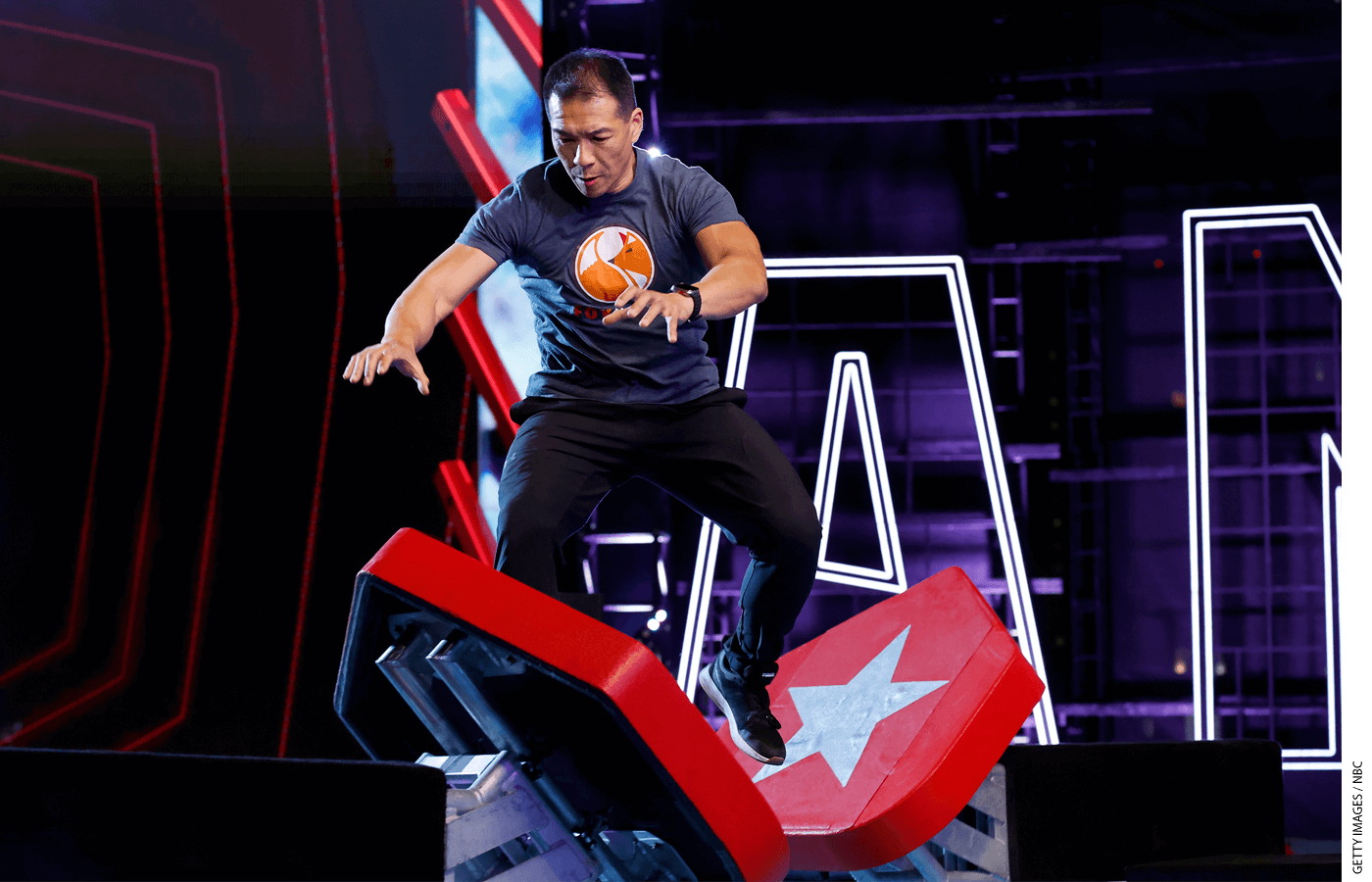
The 17th season of American Ninja Warrior (ANW)—NBC’s weird, mawkish, overproduced exercise in gymnastics-meets-parkour—is wrapping up, prompting sorrow in these parts. My kids and I are sad to bid so long to its ludicrous personalities, self-referential storylines, and affably cornball hosts (former NFL baller Akbar Gbaja-Biamila and comedian/M.D. Matt Iseman) until 2026.
If you haven’t seen the show (and there’s an excellent chance you haven’t, considering its Monday-night airings this summer drew about 2.5 million viewers an episode), it features a field of competitors battling to complete a series of obstacles suspended over big tubs of water. As the season progresses, the courses get more daunting and the athleticism ever more remarkable. The “ninjas” tend to favor t-shirts embossed with cheesy nicknames (“Flyboy,” “Flex,” “The Beast,” “The Island Ninja”), and the whole thing plays out on a rickety-looking set constructed on a Vegas side street, with the Strip always looming in the background.
Sounds ridiculous, right? But damned if I don’t love watching it with my boys. More tellingly, it’s the rare show that I feel good about watching with them. It’s two hours of carefully packaged pluck, grit, and community, dotted with the kind of soft-focus mini-features that the Olympics made famous back in the day. Some of the profiles are eye-rolling (the cowboy who trains on bales of hay), but a surprising number of them connect with even a callous SOB like me. Heart attack victims. Cancer survivors. Teens with severe trauma. Parents who’ve lost children. Competitors who’ve spent years battling back from injury. It’s a celebration of perseverance and heart.
Of course, ANW is manipulative. I’m sure plenty of the cheering is staged. I can’t possibly believe that Iseman or Gbaja-Biamila are as good-natured, square, and unfailingly enthusiastic as they come across. We’re fed a steady stream of gracious losers, with teary-eyed competitors accepting hugs and expressing gratitude. Authenticity is not the goal. It’s entertainment. And I’m not sure that’s such a bad thing.
After all, popular culture today exposes our kids to far too much authentically bad behavior up close. Social media is filled with images of authentic meanness and stupidity. Influencers work hard to infuse their wealth porn and self-promotion with faux authenticity. A pro-sports broadcast features constant low-level chatter about “real” stuff like contract negotiations, salary caps, trades, and allegations of sexual assault. And streaming networks are overstuffed with “reality” shows that avidly market their catfights, casual hook-ups, grievances, and gratuitous nastiness. Perhaps authenticity is overrated. A jerk who celebrates their jerkiness turns out to be a lousy role model. Who’d-a thunk it?
This all makes ANW’s chaste, family-friendly amateurism a welcome oasis. The show doesn’t do excuses, grievance, or victimhood. It boasts an astonishing stew in terms of age, region, avocation, race, ethnicity, and sex. My kids especially dig watching 15- and 16-year-olds dusting the grown-ups. The other week, they were jumping off the couch when 4’11” Jason Behrends qualified for the finals and when a geeky 19-year-old electrician with a bad haircut and oversized glasses torched the course. It’s a terrific illustration of the problems with stereotyping and assuming athletes or competitors look a certain way. The stars include some serious six-packs but also more than a few dad bods and scrawny teens.
There aren’t many places in this land where you see chicken farmers, teachers, college gymnasts, shipbuilders, combat veterans, stuntwomen, motivational speakers, firemen, and introverted high schoolers mingling, competing, and cheering one another’s successes. The atmosphere is all friendship and boisterous support. Competitors bring spouses, kids, and parents. Students, colleagues, and extended family are beamed in from afar.
Subscribe to Old School with Rick Hess
Get the latest from Rick, delivered straight to your inbox.
ANW feels like an endorsement of old-school amateurism—something that’s harder and harder to find in an era when travel leagues and participation fees are devouring youth sports, the Olympics are big industry, and the NCAA has morphed into another big-dollar professional league.
ANW offers something purer. Earlier this season, a 50-year-old man named Jimmy Choi, who’s had Parkinson’s since his 20s, took on the course and provided one of the most teachable moments I’ve ever seen on screen. He made it past the first obstacle and found the strength to master the course’s “Lunatic Ledges,” swinging his way across a distance of thirty feet or more. Then, despite his affliction from a disease that’s stolen his balance, he raced across five rolling logs—a demonstration of grit that can’t be manufactured. Jimmy failed on the fourth obstacle, but by then, my family was hoarse from cheering on a middle-aged man for getting partway through a televised obstacle course. (Yep, that’s a sentence I never thought I’d write.) Afterwards, we talked about Jimmy’s discipline, the grace with which he discussed his disease, and why it’s the effort, not the result, that matters.
Watching Iseman and Gbaja-Biamila celebrate Choi, I realized I don’t care whether their reactions are staged. What I care about is the model of sportsmanship and decency my kids are seeing. No excuses get made. Every effort is honored. Ripped gymnasts and painfully awkward teens get treated with equal respect. There’s no booing, just a lot of supportive signs and encouraging chants. In an era marked by loneliness, anxiety, and alienation, I can’t help but think that ninja lessons may be just what we need.
Frederick Hess is an executive editor of Education Next and the author of the blog “Old School with Rick Hess.”



